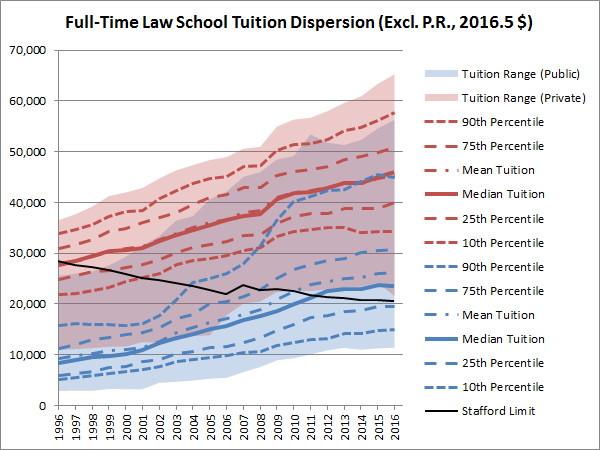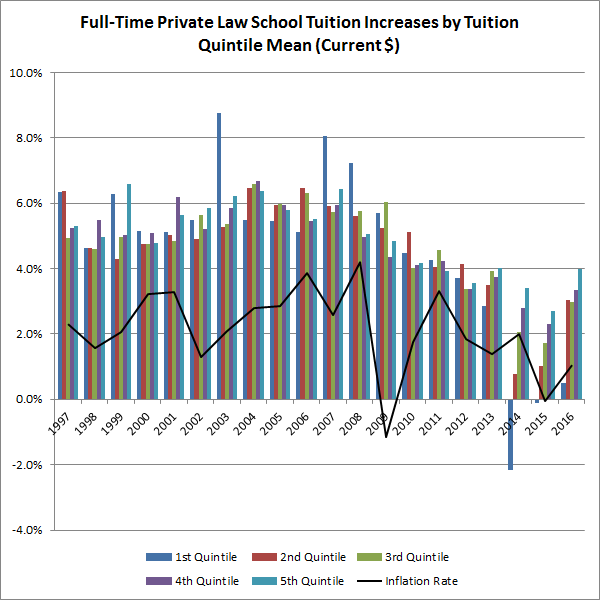Full-time tuition costs at private law schools rose an average 2.7 percent before adjusting for inflation. The rate is about 1 percent higher than the last two years’ increases, but it’s still below the typical 5 percent rate before the Great Recession. I focus on private law-school tuition because public law schools receive varying degrees of state subsidies, so they do not reflect the already distorted legal market’s prices.
Here’s what the dispersion of full-time private and full-time public (residential) tuition looks like going back to 1996:

I don’t have much to say about this that I haven’t before, but it appears that the 25th percentile public law school will soon charge more than the Stafford loan limit, which has been set at $20,500 for several years now. The limit is important because it indicates when students will need to rely on other funds to pay for their legal educations, including Grad PLUS loans, which can also go to students’ living expenses. Since 1996, Stafford loans have lost about a third of their value to inflation.
Notably costs are still widening, so after chopping up the law schools into quintiles, here’s the increases for the mean of each quintile.

The chart depicts at least three straight years of top-heavy tuition increases: The more expensive law schools are becoming more expensive—4 percent more among the top 20 percent of law schools. Two years ago, Columbia Law School became the first to charge more than $60,000, and it now costs more than $65,000. This year six other law schools joined the 60k club: NYU, Cornell, Penn, Chicago, Harvard, and USC. These seven schools raised their full-time costs by 3.8 percent on average, but theirs weren’t the largest increases. The following nine law schools raised their full-time tuition by more than 5 percent: Loyola (Calif.) (+5.4%), Michigan State (+5.5%), WMU Cooley (+6.1%), Faulkner (+6.6%), Lincoln Memorial (+6.8%), Tulsa (+7.0%), Charlotte (+7.1%), Willamette (+9.6%), and Howard (+10.9%).
It would be unfair of me not to acknowledge the handful of private law schools that cut their full-time charges: Campbell (-0.4%), Capital (-5.2%), Dayton (-6.4%), and Indiana Tech (-31.1%). Fourteen private law schools held their costs flat: New York Law School, Chicago-Kent, Brooklyn, Suffolk, Loyola (La.), Western State, Ave Maria, Western New England, Detroit, Valparaiso, Barry, Oklahoma City, Mississippi College, and Elon.
Yes, I notice that two failing law schools, Indiana Tech and Charlotte, both dealt with their incipient problems by slashing and hiking costs, respectively. For Indiana Tech, it didn’t translate into more matriculants.
Finally, 19 public law schools cut or held their residential tuition with the two most notable ones being Texas A&M (-15.4%) and UC Hastings (-9.1%). Akron, Cincinnati, and Toledo also didn’t raise their tuition, so along with Capital and Dayton that makes five of nine Ohio law schools that stand out in tuition control.
Full-time tuition costs don’t necessarily indicate what students are actually charged, but they do show how much rent law schools can extract from the government’s loan programs. For many law schools that ability is fading.
Information on this topic from prior years:
- “Full-Time Law School Tuition Still (Slowly) Rising” (December 22, 2015)
- “Law School Cuts Its Tuition to Zero (and Other 509 Report Errata)” (December 15, 2014)
- “The Official Guide is Dead, Long Live the Official Guide!” (March 31, 2014)
7 comments